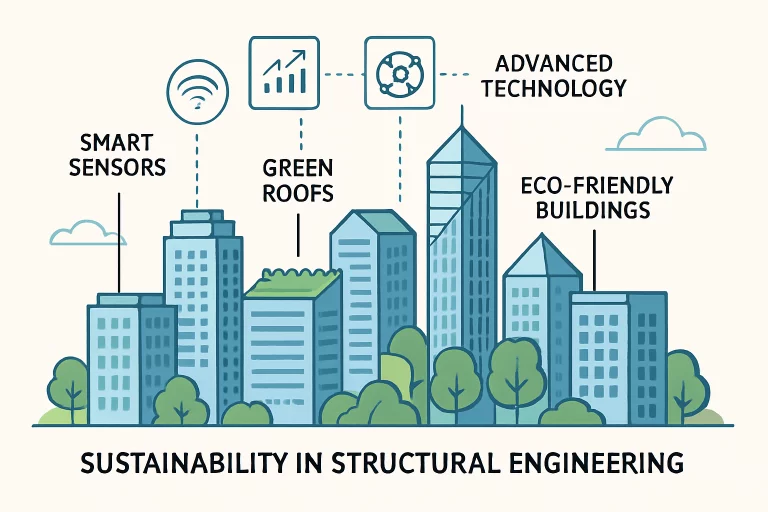AI and Machine Learning Integration
The infusion of Artificial Intelligence (AI) and Machine Learning (ML) is fundamentally changing how structural engineers operate daily. AI-driven platforms can now perform complex calculations, run multi-dimensional simulations, and automatically assess structural performance against various scenarios with minimal manual intervention. Machine learning algorithms help engineers evaluate enormous data sets, uncovering patterns and making predictive analyses that support better, faster decision-making. For instance, AI-powered modeling tools allow teams to simulate a structure’s response to various loads, material choices, or natural disasters, enhancing design accuracy and efficiency. This minimizes the risk of human error and empowers professionals to detect and resolve potential issues long before they escalate, ensuring safer and more reliable infrastructure.
Sustainable and Green Building Practices
The demand for sustainable design has created a transformative shift in the construction sector, pushing structural engineers to innovate boldly and adopt environmentally friendly processes and materials. The focus extends beyond simply using recycled materials—today, advanced building strategies like passive solar orientation, super-insulated envelopes, and smart, renewable energy integration are becoming standard. Low-carbon and self-healing concrete, recycled steel, mass timber, and other cutting-edge materials drastically reduce embodied carbon and the overall environmental impact of new projects.

Resilient Infrastructure Design
Increasingly powerful storms, wildfires, and earthquakes underscore the urgent need for infrastructure that can withstand extreme conditions. Resilient design is now a cornerstone of responsible structural engineering, as communities require buildings and infrastructure systems that can adapt to adversity and quickly recover from disruptions. Techniques such as seismic base isolation, modular flood barriers, and adaptive building envelopes are becoming essential features in new builds and retrofits, particularly in regions vulnerable to climate events. By implementing cutting-edge resilience strategies, engineers protect communities, enhance public safety, and bolster the long-term value of investments. In addition, regulatory agencies and governments continue to raise the bar for resilience in public infrastructure to address the changing risk landscape.
Internet of Things (IoT) Integration
The Internet of Things (IoT) is rapidly becoming integral to tomorrow’s built environment, facilitating interconnected and intelligent building systems. With strategically placed sensors, engineers can collect real-time data on load stress, movement, temperature, and environmental conditions from bridges, high-rises, and even roads. This doesn’t just support routine maintenance—it also allows for instantaneous responses to emerging issues, effectively reducing downtime or catastrophic failures. By linking IoT with modern building management systems, facility owners and engineers can optimize everything from energy consumption to security, gaining a comprehensive understanding of structural health and performance over time.
Augmented Reality (AR) and Virtual Reality (VR) Integration
Augmented Reality (AR) and Virtual Reality (VR) are set to redefine the visualization, design, and construction process for structural engineers and their clients. These immersive tools allow stakeholders to conduct virtual site tours, collaboratively review detailed 3D models, and even test the assembly of intricate systems—all before ground is broken. AR overlays can be used on-site, giving builders precise guides for installing complex assemblies and reducing field errors. These visualization technologies also improve collaboration across teams, expedite decision-making, and ensure higher client engagement and satisfaction. As AR and VR become more accessible, their adoption will be a key differentiator for firms seeking to streamline project timelines and achieve flawless execution.
Key Takeaways
- The future of structural engineering is shaped by technology, sustainability, and resilience.
- Practices like AI-driven design, modular construction, and IoT are redefining traditional workflows and opening up new possibilities.
- Sustainability and resilience must be central priorities, driven by global standards and increasing client awareness.
- Embracing new materials, innovative monitoring systems, and immersive design tools is essential for delivering next-generation projects.
- Industry leaders demonstrate how integrating these innovations can lead to more robust, efficient, and sustainable outcomes.
- Engineers should stay informed and adaptable to ensure relevance, deliver value, and create infrastructure that will last.
Related posts
More Reads
How to Keep Your Carpets Fresh and Allergen-Free Year Round
Keeping your carpets clean is fundamental not only for the look and feel of your living space but also for…
Real Stories of Recovery: PTSD Treatment for First Responders Who Found Hope
Every day, paramedics, firefighters, police officers, and other frontline professionals deal with the kind of life-threatening emergencies most people only…



